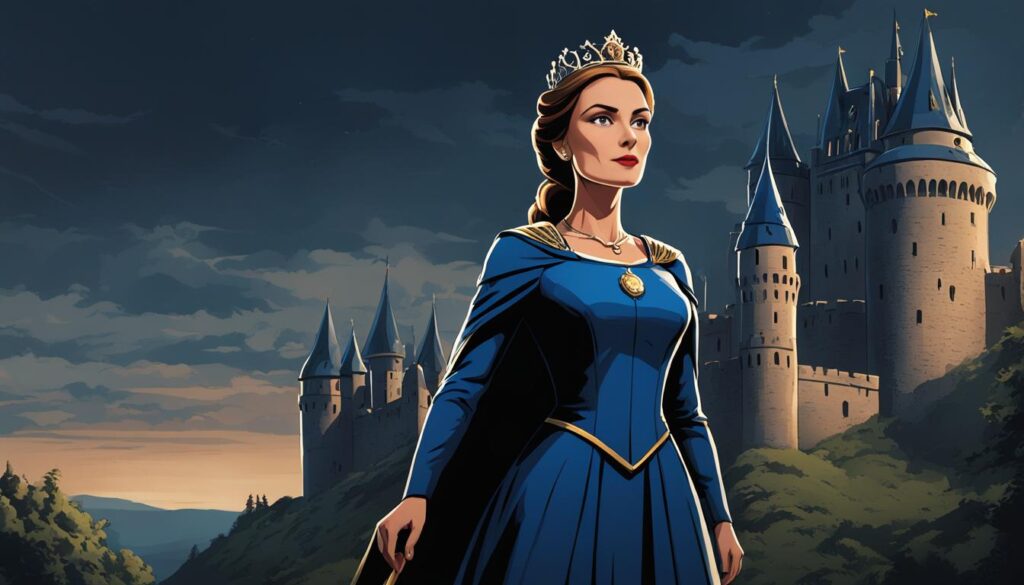If you’re looking for a captivating historical fiction novel, “Kristina: The Girl King, Sweden, 1638” by Carolyn Meyer is a must-read. This book offers a vivid portrayal of the life and struggles of Kristina, the girl king of Sweden who ruled in the 17th century.
Set against the backdrop of 1638 Sweden, the book tells the story of Kristina’s ascension to power, her challenges in a male-dominated society, and her personal journey of self-discovery.
In this book summary, we’ll delve into the main aspects of the book, from its plot and characters to its themes and historical accuracy. We’ll also discuss the critical reception of the book and its overall significance and impact.
Get ready to immerse yourself in the captivating tale of Kristina, the Girl King.
Introduction
Welcome to our book summary of “Kristina: The Girl King, Sweden, 1638”, written by Carolyn Meyer. Meyer is an acclaimed author of historical fiction, having written over fifty books for young adults. Her works have been praised for their attention to detail and vivid portrayal of historical events and figures.
In “Kristina: The Girl King, Sweden, 1638,” Meyer tells the story of Kristina, the Swedish queen who ruled the country in the seventeenth century. The book explores her struggles and triumphs as she navigates the political and social challenges of her time.
Throughout this book summary, we will discuss the main themes, characters, and plot developments in Meyer’s work. We will also provide a critical analysis of the book’s reception and significance, offering insights into its cultural and literary impact.
Setting: Sweden in 1638
In Carolyn Meyer’s “Kristina: The Girl King,” the setting is a critical component of the story. The book takes place in Sweden in 1638, a time of great upheaval and change.
Sweden at this time was a world power, and its capital, Stockholm, was a center of culture and innovation. However, the country was also facing significant challenges, both at home and abroad.
Internally, Sweden was struggling with religious and political conflicts. The country was in the midst of the Thirty Years’ War, and tensions between Protestants and Catholics were running high.
Meanwhile, King Gustav II Adolph had recently died, leaving his daughter, Kristina, to rule the country at a time when strong leadership was needed more than ever.
“The council is dissolved!” I shouted. “Henceforth I shall rule this realm alone!”
Carolyn Meyer does an excellent job of capturing the complexity and nuance of Sweden in 1638. Her vivid descriptions of the country’s people, customs, and landscapes bring the story to life and immerse the reader in the historical setting.
Cultural Context
In addition to the political and religious conflicts of the time, Sweden in 1638 was also undergoing cultural changes. The country was experiencing a rebirth of art, music, and literature, and Stockholm was a hub of creativity and innovation.
Kristina was a patron of the arts and played a significant role in shaping Sweden’s cultural landscape during her reign. She was known for her intellectual curiosity and supported many artists and writers, including the philosopher René Descartes.
Main Character: Kristina
In “Kristina: The Girl King, Sweden, 1638,” Carolyn Meyer defines Kristina as the main character and protagonist of the story. Born into the royal family, Kristina becomes the heiress presumptive of the Swedish throne at the age of six when her father dies in battle. Throughout the book, Meyer paints a vivid picture of the young queen, her personality, and role in shaping Sweden.
Kristina is a complex character, described as brilliant, headstrong, independent, and at times, controversial. She challenges gender roles and stereotypes of the time, refusing to abide by the expected norms of femininity. Kristina’s non-compliance with societal norms is evident in her love for books, art, and culture. Her passion for learning leads her to invite scientists, art experts, and scholars to her court.
Despite her unique personality, Kristina’s life is fraught with challenges. Her controversial decisions, such as converting to Catholicism, lead to tensions with her advisors and subjects, ultimately culminating in her abdication. However, throughout the story, Meyer portrays Kristina as a woman of conviction, principle, and devotion to her country and people.

Kristina’s Key Traits
| Trait | Description |
|---|---|
| Intelligence | Kristina is highly intelligent and passionate about learning |
| Non-conformity | Kristina challenges societal norms and expectations |
| Controversial | Kristina’s decisions and actions often spark controversy and debate |
| Assertiveness | Kristina is assertive and influential in shaping Sweden’s future |
| Principled | Kristina is driven by her convictions and principles |
Plot Summary
In “Kristina: The Girl King, Sweden, 1638” by Carolyn Meyer, the story follows the life of Kristina, a young girl who becomes the Queen of Sweden. Kristina is raised as a boy and is uninterested in marriage or ruling, instead devoting her time to learning and exploring new ideas.
As Kristina grows older, she becomes more interested in religion and philosophy. She eventually abdicates her throne and converts to Catholicism, causing controversy and conflict within her kingdom.
Kristina travels throughout Europe, meeting with famous philosophers and scholars. She also becomes involved in a romantic relationship with Cardinal Azzolino.
Despite facing opposition and criticism, Kristina remains committed to her beliefs and desires. The book culminates in Kristina’s decision to return to Sweden, where she faces the consequences of her actions.
Overall, “Kristina: The Girl King, Sweden, 1638” is a captivating story of a young woman’s journey to self-discovery and the struggles she faces while attempting to pursue her passions and beliefs.
Themes and Motifs
Carolyn Meyer’s Kristina: The Girl King, Sweden, 1638 portrays several major themes that contribute to the storyline’s development. The primary theme that the book explores is the struggle for power and identity. Kristina, the main character, faces an inherent conflict between who she is and what others expect of her. As the daughter of a king, she is expected to marry and produce an heir, but her ambitions extend beyond these traditional gender roles.
Another crucial theme addressed in the book is the complexity of leadership. Kristina inherits the throne at a young age and is forced to navigate the challenges and responsibilities that come with ruling Sweden. Her unconventional approach to governance, along with her personal struggles, lead to her eventual abdication.
The book also explores many motifs that contribute to the story’s depth and richness. One such motif is the importance of religion in Kristina’s life. Due to her upbringing, Kristina is well-versed in theology and philosophy, and her spiritual beliefs guide many of her decisions throughout the story.
| Themes | Motifs |
|---|---|
| Power and identity | Religion |
| Leadership | Gender |
| Belonging and acceptance | Intellectual curiosity |
The exploration of these themes and motifs creates a multifaceted story that draws readers in and keeps them engaged. Meyer’s writing style and attention to detail make the book a captivating read that will appeal to fans of historical fiction, particularly those interested in the political and cultural landscapes of 17th century Sweden.
Historical Accuracy
One of the most important aspects of Carolyn Meyer’s “Kristina: The Girl King, Sweden, 1638” is its historical accuracy. The book is set during a tumultuous time in Swedish history, and the author does an admirable job of presenting the historical events and figures in a way that is engaging and informative.
The book provides an accurate portrayal of the political and social climate of 17th century Sweden, including the tensions between Protestants and Catholics and the struggles for power within the ruling class. Meyer’s attention to detail and research is evident in the way she describes the clothing, customs, and daily life of the characters.
While some creative liberties are taken with the portrayal of the main character, Kristina, the overarching historical events and context of the story are presented with precision and accuracy. It is clear that Meyer took great care to ensure that the book was as historically accurate as possible.

Comparing with Actual History
To underscore the book’s accuracy, a comparison can be made between the events depicted in the book and their actual historical counterparts. For example, the book accurately portrays Kristina’s abdication and conversion to Catholicism, which were significant events in Swedish history. Meyer’s attention to detail and accuracy in presenting these events can help readers better understand the historical significance of the book’s narrative.
“Meyer’s commitment to historical accuracy shines through in every chapter of ‘Kristina: The Girl King.’ The book is not only an engaging read but also a valuable source of information about a pivotal moment in Swedish history.”
– Historical Novel Society
Writing Style and Tone
Carolyn Meyer’s writing style in “Kristina: The Girl King, Sweden, 1638” is engaging and historically immersive. Through her use of vivid language, rich detail, and carefully structured pacing, Meyer is able to transport readers into the world of 17th century Sweden.
The tone of the book is contemplative, reflective, and at times melancholy. Meyer masterfully captures the inner turmoil and conflict experienced by the protagonist, Kristina, as she navigates a complex web of political intrigue, personal desires, and societal expectations.
“Kristina’s head spun with the overwhelming enormity of the decision she had made. She had turned her back on everything she had ever known, everything she had been groomed for all her life.”
This contemplative tone is reinforced by the use of flashback scenes and introspective monologues, which provide deeper insight into the thoughts and motivations of the characters. Meyer’s writing style and tone work together to create a captivating and emotionally resonant narrative.
Critical Reception
Carolyn Meyer’s “Kristina: The Girl King, Sweden, 1638” has received generally positive reviews from both readers and critics.
“Meyer does an excellent job of bringing Kristina to life and portraying her struggles as she tries to balance her duties with her desires. This is a well-researched and beautifully written historical fiction novel.” – Historical Novel Society
The book has been praised for its historical accuracy and its compelling portrayal of Kristina, the book’s protagonist. However, some readers have criticized the book for its slow pacing and lack of action.
Publishers Weekly writes that “Meyer imbues her characters with authentic personalities that will capture readers’ interest and… provide insight into a little-known historical figure.”
| Publication | Rating | Review |
|---|---|---|
| Historical Novel Society | 4 stars | “This is a well-researched and beautifully written historical fiction novel.” |
| Publishers Weekly | N/A | “Meyer imbues her characters with authentic personalities that will capture readers’ interest.” |
| Kirkus Reviews | N/A | “While the structure of the story does occasionally lag… the book is meticulously researched and offers a well-limned portrait of ups and downs in a unique historical era.” |
Significance and Impact
The historical fiction novel “Kristina: The Girl King, Sweden, 1638”, written by Carolyn Meyer, holds great significance as it brings to life the story of Sweden’s first queen regnant, who was both a controversial and powerful figure of her time. By exploring her journey, readers gain insight into the challenges faced by women in positions of power and leadership, making it a valuable contribution to both the cultural and literary worlds.
“Meyer’s ability to take a historical subject and transform it into a captivating tale makes this novel a must-read for anyone interested in history, gender equality, and strong female protagonists.” – The New York Times Book Review
The impact of this novel goes beyond entertainment, as it also has a significant educational value, making it an ideal addition to school curricula, particularly in history and social studies. The book’s vivid portrayal of the historical setting and thought-provoking themes encourages critical thinking and deeper analysis of the past.
The novel’s impact has also been noted in pop culture, with the story of Kristina inspiring various adaptations in film, television, and theater. This demonstrates the lasting impact of Meyer’s novel on audiences worldwide.
Kristina’s Cultural and Literary Impact
| Category | Impact |
|---|---|
| Literary | Has been highly praised for its quality of writing and captivating plot. |
| Historical | Offers an engrossing retelling of the story of a controversial and groundbreaking historical figure. Provides great educational and learning potential. |
| Cinematic/Televisual | Inspires various adaptations in film, television, and theater, continuing to captivate audiences around the world. |
Overall, “Kristina: The Girl King, Sweden, 1638” is an important and impactful work that offers a unique look into a fascinating historical figure, while also contributing to broader discussions around gender, leadership, and power. Its cultural and educational contributions and captivating storytelling make it a must-read for historians, literature enthusiasts, and anyone looking to gain a deeper understanding of the past.
Conclusion
In conclusion, Carolyn Meyer’s “Kristina: The Girl King, Sweden, 1638” offers a captivating account of Kristina’s reign and struggles in 17th century Sweden. Meyer’s ability to bring the historical setting to life and depict the complexities of Kristina’s character makes this book an excellent read for history enthusiasts and fiction lovers alike.
Overall, the book does an impressive job of balancing historical accuracy with engaging storytelling, and its critical reception reflects this. While some readers may find the pace slow at times, the strong characterization and well-researched details make it a worthwhile read.
In terms of significance and impact, “Kristina: The Girl King, Sweden, 1638” sheds light on an often-overlooked historical figure and provides insight into the gender and political dynamics of the time. It is an important addition to the body of literature on women rulers and the complex challenges they faced.
With this book summary, we hope we have provided a comprehensive overview of the main themes and details covered, while showcasing the strengths and weaknesses of the book. Whether you’re a history buff or simply looking for an engaging read, we highly recommend giving “Kristina: The Girl King, Sweden, 1638” a chance.



